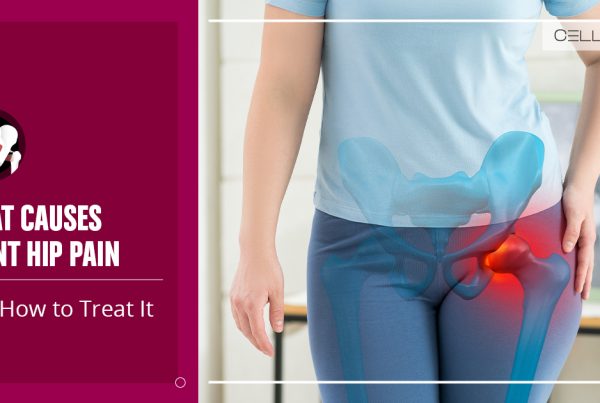Published on: January 27, 2023 | Updated on: August 29, 2024
The pelvis is the area of the body located below the abdomen and between the hips. It contains the bladder, colon, and internal reproductive organs (vagina, uterus, fallopian tubes, ovaries, prostate, urethra, etc.)
Pelvic pain is located in the above-mentioned pelvic area. It is a common problem, especially prevalent among women.
In this article, we explain pelvic pain, its types, causes, symptoms, and associated health complications. Additionally, we also discuss medical and alternative treatment options available for it.
Types Of Pelvic Pain

Pelvic pain has two main types; acute and chronic:
- Acute Pelvic Pain: In medicine, pain is characterized as acute and chronic based on the time it lasts. Lower abdominal pain lasting less than three months is termed acute pelvic pain. It affects one-third of women (in the reproductive age group).
- Chronic Pelvic Pain: It is pelvic pain that lasts six months or longer. It can present as mild, continuous pain, or it can be severe and transient (comes and goes).
Pelvic pain can arise due to several different reasons. Based on the pathology, the resultant pain feels different for each disease /condition, which plays an important role in diagnosis. Therefore, when you visit a doctor, they’ll inquire about the characteristics of pelvic pain, apart from asking about its time frame.
Here are the different ways pelvic pain can present as:
- Sudden onset, sharp, stabbing pain
- Gradual onset pelvic pain that increases with time (progressive in nature)
- Cramping /throbbing pain
- Dull, continuous pain that does not vary in severity with time
- Pain during exertion (physical activity /exercise, urination) or at times of stress
Please note that the pain may or may not be transient. Additionally, it might be associated with movement and position (for example, it worsens on leaning forward, when standing, or sitting down, etc.)
Causes Of Pelvic Pain
The main causes of pelvic pain are:
- Menstrual Cramps: During menstruation, prostaglandins (hormones) are released to stimulate uterine contraction. The chemical release, paired with muscle cramping, causes pelvic pain.
- Ovulation: Ovulation typically occurs on the 14th day of your menstrual cycle. Follicular rupture precedes ovum release, and the resultant irritation to the abdominal lining causes pain.
- Pregnancy: Pelvic pain is a common occurrence in pregnancy (especially in the second trimester) and is usually felt as a sharp, stabbing sensation.
- Ectopic Pregnancy: When the fertilized ovum is embedded in any place other than the uterus, the condition is called an ectopic pregnancy. It is a complicated condition that often results in hemorrhage and irritation of surrounding nerves. This causes mild, dull pain in the pelvis, abdomen, shoulder, and neck.
- Miscarriage: Dead fetus is septic, which is why the uterus contracts following a miscarriage to expel the contents. This causes pelvic pain.
- Endometriosis: Endometriosis is a common disease (affecting 10% of women of reproductive age) in which the typically internal lining of the uterus grows outside of it. Apart from pressing on the surrounding organs (bowel, bladder, etc.), this abnormal tissue also responds to prostaglandins and other menstrual hormones, resulting in pelvic pain.
- Ovarian Cyst: Large ovarian cysts lead to abnormal twisting /torsion of the ovary, which leads to pelvic pain. The pain can also occur because of ovarian ischemia (severed blood supply) as a result of torsion.
- Ovarian Cancer: According to the CDC, ovarian cancer is the second most common gynecologic cancer in the USA. Due to inflammation, ovarian torsion, as well as pressing on the surrounding nerves, vessels, and organs, the tumor can cause pelvic pain.
- GI Disorders: Gastrointestinal disorders like inflammatory bowel syndrome (IBS) and constipation are common causes of pelvic pain.
- Appendicitis and Peritonitis: Both appendicitis and peritonitis are surgical emergencies. While the former causes persistent and dull, aching pelvic pain, the latter results in constant, severe pain that is exacerbated by movement.
- STIs and UTIs: Sexually transmitted infections (STIs) can spread into your pelvic organs resulting in pain and vaginal discharge. In the case of urinary tract infections (UTIs), the inflammation in the bladder and urinary tract causes pelvic pain.
Treatment Of Pelvic Pain
Pelvic pain treatment primarily involves treating the underlying cause.
Exercise
Exercise and physical therapy is often advised for people suffering from chronic pelvic pain. Certain activities that reduce pelvic strain, like walking, swimming, etc., are recommended for the patients to stay healthy.
Additionally, stretching, massage, and yoga pose for relaxation can also alleviate pain and associated symptoms.
Medicines
Medicines are often administered to reduce or cure pelvic pain resulting from endometriosis, tumors, IBS, and other GI disorders. Painkillers also come in handy for pelvic pain when surgery is contraindicated.
Surgery
Surgery specific to the cause of pelvic pain, like appendectomy, removal of the tumor, hysterectomy, laparoscopy, etc., is also performed when necessary.
Orthobiological Methods
Now that we have discussed the main modes of treatment let’s go through some alternative methods that can relieve pelvic pain.
Cell-Based Therapy
Stem cells are raw materials of the body. During the embryonic stage, stem cells differentiate into organs and tissues with a specific function. After birth, small amounts of these cells persist in the spine and bone marrow.
In cases of chronic pelvic pain due to injury or organ damage, the body often fails to replace dead cells with functional, healthy ones. Cell-based therapy is the part of regenerative medicine that involves transplanting stem cells at the damaged site to grow healthy tissue. This reduces /eliminates pelvic pain.
PRP Injections
Platelet-rich plasma or PRP injections are another type of orthobiological alternative treatment for pelvic pain.
Platelets are components of blood cells involved in modulating inflammation. Since platelets can dampen aggravated inflammatory substances (characteristic of pelvic pain), PRP injections are given to treat chronic pain.
The therapy involves drawing a patient’s blood, isolating platelets from it, and then injecting the platelets into the injured site.
Both stem cell therapy and PRP injections have minimal side effects and incredible success rates. At CELLAXYS, we perform both procedures in our outpatient department. Our team of skilled and renowned physicians makes sure to follow the proper protocol that maximizes pain relief.
Sources
Footnotes
- Berkley KJ. A life of pelvic pain. Physiology & behavior. 2005 Oct 15;86(3):272-80.
- Howard FM. Chronic pelvic pain. Obstetrics & Gynecology. 2003;101(3):594-611.
- Lamvu G, Steege JF. The anatomy and neurophysiology of pelvic pain. Journal of minimally invasive gynecology. 2006;13(6):516-22.
- Zondervan K, Barlow DH. Epidemiology of chronic pelvic pain. Best Practice & Research Clinical Obstetrics & Gynaecology. 2000;14(3):403-14.
- Slocumb JC. Neurological factors in chronic pelvic pain: trigger points and the abdominal pelvic pain syndrome. American Journal of Obstetrics and Gynecology. 1984;149(5):536-43.
- Smith SE, Eckert JM. Interventional pain management and female pelvic pain: Considerations for diagnosis and treatment. InSeminars in reproductive medicine 2018 (Vol. 36, No. 02, pp. 159-163). Thieme Medical Publishers.
References
- Chronic pelvic pain. Mayo Clinic. Accessed 2/26/2024.
- Slideshow: What’s Causing Your Pelvic Pain?. WebMD. Accessed 2/26/2024.
- Pelvic Pain. Cleveland Clinic. Accessed 2/26/2024.
CELLAXYS does not offer Stem Cell Therapy as a cure for any medical condition. No statements or treatments presented by Cellaxys have been evaluated or approved by the Food and Drug Administration (FDA). This site contains no medical advice. All statements and opinions are provided for educational and informational purposes only.
Dr Pouya Mohajer
Author
Pouya Mohajer, M.D. is the Director of Spine and Interventional Medicine for CELLAXYS: Age, Regenerative, and Interventional Medicine Centers. He has over 20 years of experience in pain management, perioperative medicine, and anesthesiology. Dr. Mohajer founded and is the Medical Director of Southern Nevada Pain Specialists and PRIMMED Clinics. He has dedicated his career to surgical innovation and scientific advancement. More about the doctor on this page.
Dr Pejman Bady
Contributor
Dr. Pejman Bady began his career over 20 years ago in Family/Emergency Medicine, working in fast-paced emergency departments in Nevada and Kansas. He has served the people of Las Vegas as a physician for over two decades. Throughout this time, he has been met with much acclaim and is now the head of Emergency Medical Services in Nye County, Nevada. More about the doctor on this page.









